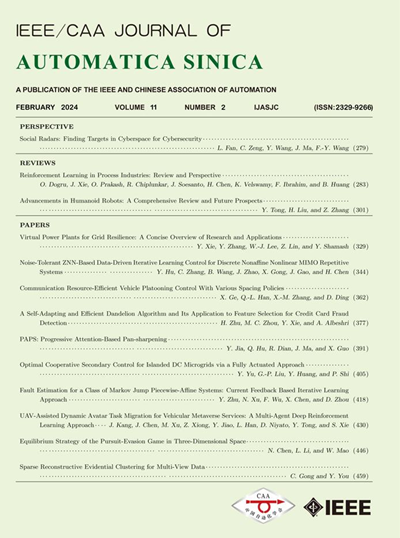SILIC: Intelligent On/Off Control for Networked Solar Insecticidal Lamps
IF 19.2
1区 计算机科学
Q1 AUTOMATION & CONTROL SYSTEMS
引用次数: 0
Abstract
The solar insecticidal lamp (SIL) is an innovative green control device. Nevertheless, a major challenge is often encountered when carrying out insecticidal work is low energy utilization efficiency. The substantial energy consumption required to turn on the SIL, coupled with the extension of insecticidal working time during the low pest activity periods, can result in low energy efficiency. Especially when the energy storage level is below 50%, the inefficient use of energy significantly reduces the effectiveness of pest control. Consequently, an ineffective on/off scheme for these lamps may lead to suboptimal energy utilization. In this paper, we present the solar insecticidal lamp intelligent energy management scheme (SIL-IEMS) to address the challenge of inefficient energy utilization in the solar insecticidal lamp internet of things (SIL-IoT). SIL-IEMS primarily utilizes genetic algorithm (GA) and greedy algorithms to optimize insecticidal working time by considering constraints such as residual energy and the number of trap pests. Comparing SIL-IEMS to the traditional remote switching method (TRSM) and the solar insecticidal lamp genetic algorithm (SILGA), our simulation results showcase its superior energy efficiency and pest control effectiveness. Particularly noteworthy is the SILIEMS's 17.6% increase in insecticidal efficiency compared to TRSM and 6% improvement over SILGA when the SIL begins with a remaining energy level of 15%.SILIC:联网太阳能杀虫灯的智能开/关控制
太阳能杀虫灯(SIL)是一种创新的绿色控制装置。然而,在进行杀虫工作时经常遇到的一个主要挑战是能源利用效率低。开启SIL所需的大量能源消耗,加上在害虫低度活动期间杀虫剂工作时间的延长,可能导致能源效率低。特别是当蓄能水平低于50%时,能源的低效利用显著降低了害虫防治的有效性。因此,这些灯的一个无效的开/关方案可能导致次优的能源利用。本文提出了太阳能杀虫灯智能能源管理方案(SIL-IEMS),以解决太阳能杀虫灯物联网(SIL-IoT)中能源利用效率低下的挑战。SIL-IEMS主要利用遗传算法(GA)和贪婪算法,通过考虑剩余能量和陷阱害虫数量等约束来优化杀虫工作时间。将SIL-IEMS与传统的远程开关方法(TRSM)和太阳能杀虫灯遗传算法(SILGA)进行比较,仿真结果表明其具有优越的能源效率和害虫防治效果。特别值得注意的是,当SIL开始时剩余能量水平为15%时,sililems的杀虫效率比TRSM提高了17.6%,比SILGA提高了6%。
本文章由计算机程序翻译,如有差异,请以英文原文为准。
求助全文
约1分钟内获得全文
求助全文
来源期刊

Ieee-Caa Journal of Automatica Sinica
Engineering-Control and Systems Engineering
CiteScore
23.50
自引率
11.00%
发文量
880
期刊介绍:
The IEEE/CAA Journal of Automatica Sinica is a reputable journal that publishes high-quality papers in English on original theoretical/experimental research and development in the field of automation. The journal covers a wide range of topics including automatic control, artificial intelligence and intelligent control, systems theory and engineering, pattern recognition and intelligent systems, automation engineering and applications, information processing and information systems, network-based automation, robotics, sensing and measurement, and navigation, guidance, and control.
Additionally, the journal is abstracted/indexed in several prominent databases including SCIE (Science Citation Index Expanded), EI (Engineering Index), Inspec, Scopus, SCImago, DBLP, CNKI (China National Knowledge Infrastructure), CSCD (Chinese Science Citation Database), and IEEE Xplore.
 求助内容:
求助内容: 应助结果提醒方式:
应助结果提醒方式:


